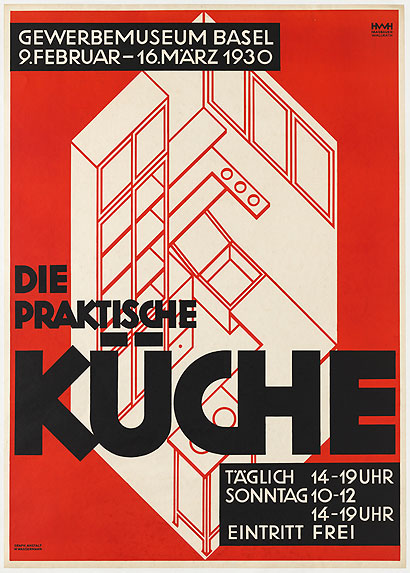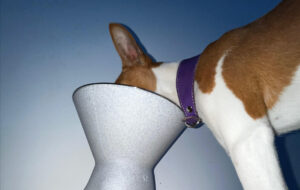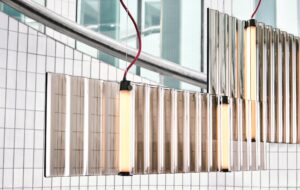|
|
||
|
In case you hadn’t noticed, we live in a golden era of the culinary arts. Ours is a time of “snout-to-tail”, “farm-to-table” cooking, of “molecular gastronomy”, of celebrity chefs. The hearth, once the centerpiece of the home, has been displaced by a restaurant-grade, brushed-steel range that pumps out enough BTU to power a small factory. Which is all to say, this is the ideal moment for Counter Space: Design and the Modern Kitchen, which opened in September at the Museum of Modern Art, New York City. The exhibition, if well timed, is a bit of a stew: chock full of fine ingredients that don’t quite coalesce into a unified whole. In a one-room gallery just steps from the museum’s cafe, curator Juliet Kinchin has ambitiously mounted what might be three separate exhibitions: an industrial design review of cooking implements and related ephemera; a more sociologically driven survey of women and the kitchen; and, finally, a look at the kitchen refracted through works of art from the museum’s permanent collection.
credit Spazio Vivo Mobile Kitchen Unit for Snaidero by Virgilio Forchiassin, 1968. The Museum of Modern Art, New York. Certainly there are highlights, in particular the show’s centrepiece, one of Margarete Schütte-Lihotzky’s prefabricated Frankfurt Kitchens of 1926-27, fully assembled and floating somewhat aimlessly at the front of the gallery. A battleship-grey unit with integrated storage and preparation spaces, it is a model of functionalist design. Some 10,000 were installed in Germany during the interwar years, making it the mother of galley kitchens the world over. Contemporary audiences may be surprised to find its counters at desk height. The hausfraus of the Rhineland, apparently, were expected to prepare their wurst while seated. That would never pass muster with Henry Dreyfuss, the industrial designer who epitomised postwar America’s obsession with efficiency. Dreyfuss arrives at the midpoint of Counter Space, as the austerities of the Second World War – illustrated by a wonderful 1942 Abram Games poster urging Britons to “Grow Your Own Food” – give way to the abundance of consumer capitalism. From Dreyfuss, we have “Josephine”, a measured female figure diagrammed in 1967 to facilitate designs of maximum productivity. Just a few steps, and perhaps a giant intellectual leap, away is Virgilio Forchiassin’s mobile kitchen unit of 1968, hinged and resting on casters like some very mod airline beverage cart. In half a century, Schütte-Lihotsky’s functionalist dream had come full circle. The modern kitchen designed to liberate the individual from drudgery had become a stylised entertainment unit, a site of play not work. Oddly absent from Counter Space is Julia Child, the woman who did more than anyone to shape the kitchen, at least in America, as a defining space for those practicing a modern lifestyle. Actually, she is not entirely absent; she is the presumed butt of a 1974 video, Semiotics of the Kitchen, in which the artist Martha Rosler parodies her demonstration cooking program, The French Chef. It would have been an instructive lesson on the trajectory of feminist thinking, not to mention entertaining, to see Rosler’s video, described by Kinchin as a commentary on “oppressive women’s roles”, placed side-by-side with footage of Child in action. As it is, Semiotics of the Kitchen is one of the more successfully deployed art works in the exhibition. A pair of 1964 Andy Warhol Brillo Boxes, for instance, seem neutered and oddly lifeless when recontextualised with so much kitchen paraphernalia. After several trips through the gallery, I’m still not sure of precisely how those works fit into a narrative with an 1897 protein extract poster by Henry van de Velde, a 1975 plastic hamburger made in Japan, and a 1994-95 James Dyson Dual Cyclone vacuum cleaner. Sometimes it’s best not to raid the entire pantry, however appealing the contents. The exhibition Counter Space: Design and the Modern Kitchen is at MoMA, New York until 14 March 2011.
credit Serving Bowl by Kenneth Brozen, 1963. The Museum of Modern Art, New York.
credit Helene Haasbauer-Wallrath, Die Praktische Kuche (The Practical Kitchen), exhibition poster, 1930. |
Image Alcan Foil Brochures for the Aluminum Company of Canada by Rolf Harder c.1960-62. The Museum of Modern Art, New York
Words Mark Lamster |
|
|
||


















